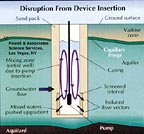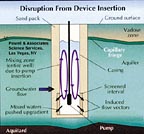
Studies have shown that ground water in the screened interval of a standard monitoring well can be representative of that in the formation, even though stagnant water lies above in the casing. This occurs when flow is generally horizontal and naturally purges the screened interval (See Figure 1). Unfortunately, the insertion of a sampling device, such as a pump, bailer or even a tube, can disrupt this equilibrium and cause mixing of the screened and cased interval waters (See Figure 2). The mixture of stagnant and screened interval water can even potentially be forced into the aquifer in all directions, including upgradient. This can result in unpredictable geochemical and microbiological effects that may affect data quality from the well over the short, and possibly long, term.
Following device insertion, some amount of time must elapse before the equilibrium is re-established. Therefore, both low-flow and passive sampling techniques are most accurate using dedicated sampling devices that can be left down-hole. Alternatively, if devices cannot be dedicated, the sampling devices can be slowly and carefully inserted and left until the screen/casing equilibrium returns or is approximated. This allows a pump, for example, to be used in multiple wells, but requires additional time and planning. Both these approaches minimize - and potentially eliminate - purge time and volume.
Possibly less accurate, but still typically yielding data superior to high-flow techniques, is careful device insertion followed immediately by low-flow purging and sampling.

Low-flow Purging and Sampling
This method of sampling is now well documented and becoming widely adopted. It basically consists of only a few modifications to traditional techniques that sample ground water with pumps.The pump inlet is placed in the screened interval at the point where the contaminant concentration is desired (but not at the very bottom of the borehole due to the accumulation of solids in this region). Usually, the desired location is the zone of highest contaminant concentration. Short screened intervals across this zone are desirable for the reasons discussed in Part 2 of this series (January 2004). Purging then is begun, typically at a rate of 0.1 to 0.5 quarts per minute, although rates up to 1 quart per minute may be allowable in highly transmissive formations.
During the course of purging, certain parameters should be tracked to determine when they become reasonably stable, indicating sampling continuity with the formation water. If possible, these parameters should be measured directly in the flow stream very near the well head to eliminate atmospheric exposure and temperature changes. Traditionally, pH, temperature and conductivity have been used as these parameters. Temperature and pH have been shown to be insensitive, however, relative to dissolved oxygen (DO), Eh and turbidity. Whenever possible, the concentration of the contaminant(s) of interest also should be tracked for stability. The parameters usually are considered stable when three consecutive readings within ± 10 percent of one another for DO and turbidity (or ± 10 mV for Eh) are obtained over a three-minute to 10-minute period. At that time, samples are acquired, typically unfiltered due to the reasons discussed in Part 1 of this series (December 2003).

Passive Sampling
Passive sampling requires stabilized well conditions, as previously discussed, but generates the lowest purge volume of any of the sampling techniques. Used properly, it also has the potential for providing the best contaminant concentration data. The most accurate data is likely to be obtained from small diameter (< 2 inch) wells without sand packs, with short (1 ft. or less) screened intervals placed directly in the zones of interest. Often these wells are nested to allow sampling of multiple depths at the same surface location. When the sampling depth is within suction lift range, peristaltic pumps have been shown to work well for inorganics, although volatile organic constituents may be somewhat biased to lower than actual values. At greater depths, or for the most accurate determinations of volatile organic compounds, low-speed submersible and bladder pumps can be used.One goal of passive sampling is to obtain the needed samples with the minimum possible disturbance to the water in the well. Increased disturbance translates to increased purging volume and time. With dedicated samplers and passive sampling techniques, the only purging required is to evacuate the sampling device (pump body, tubing, etc.) itself.
A typical passive-sampling scenario can be as simple as:
1) Adjust the pump/controller to the proper (slow) sampling speed and turn it off.
2) Attach the pump/controller to the tubing exiting the well and start the pump.
3) Purge enough water to remove the sampling device volume at least once (two to three times might be preferable but the risk of acquiring stagnant casing water increases with each device volume removed, especially when sampling a non-transmissive formation).
4) Collect and preserve the samples.
5) Measure the water level (Note: this step should always follow the sampling when using passive techniques to avoid initial disturbance to the stagnant water).
6) Close up and proceed to the next well.
The “slow” pump rate referred to in this procedure is far slower than typically used. A suggested range could be somewhere between 10 ml per minute to 100 ml per minute, depending somewhat on the hydraulic characteristics of the screened interval and the natural pore water velocity in that zone, as well as limitations of the sampling device.

A potential method for resolving such discrepancies is the use of data from a Geoprobe, HydroPunch or other similar push-tool technology (provided the push samples have been taken in the same three-dimensional location as the current well emplacement). This may not be considered practical for older monitoring wells but, increasingly, the locations of new monitoring wells and screened intervals are being based on such data. ND
Report Abusive Comment